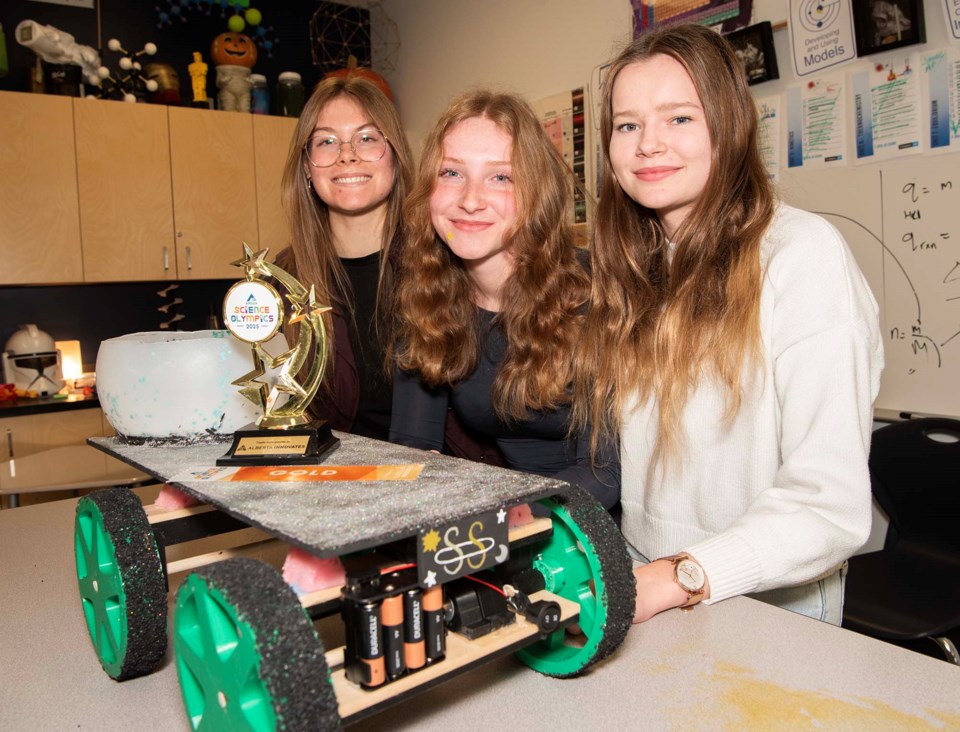Tiny homes, mobile magnetometers, and pointy sticks helped two St. Albert teams win gold at last weekend’s Science Olympics in Edmonton.
Some 1,200 Grade 1–12 students from throughout the Edmonton region rallied at the Butterdome April 5 for the 2025 APEGA Edmonton Science Olympics. Organized by the Association of Professional Engineers and Geoscientists of Alberta (APEGA), this popular event sees students compete in various challenges to inspire interest in scientific and engineering careers.
Teams of up to five students had three months to complete a take-home challenge and a few hours to finish surprise events revealed on the day of competition, said APEGA outreach co-ordinator Chelsea Brown. Each challenge was linked to the Alberta school curriculum and designed by professional engineers and geoscientists. Teams scored points based on their results, and could take home gold, silver, or bronze ribbons and trophies if they met certain thresholds.
Medal winners
Paul Kane Grade 12 students Daria Tsybukova, Laura Steinerte, and Lauryn Skrypnek earned gold at the Olympics as members of Team Solar Sisters. Their take-home challenge was to build a mobile device that could scan a field for minerals (magnets, in this case) using a magnetometer.
While other teams built complex, sometimes remote-controlled vehicles, Tsybukova said the Solar Sisters went with a much-simpler four-wheeled rover with 3D-printed wheels and recycled rubber-crumb grip sourced from Alberta Environmental Rubber Products. They also enhanced their rover with glitter, paint, and a custom license plate.
“For us it was important to show that [science and engineering] doesn’t just have to be practical; it can look pretty and it can be fun,” she said.
One big issue with this challenge was the sensitivity of the magnetometer, which could be thrown off by the slightest bumps, Tsybukova said. The team compensated by floating the device in a bowl of water atop a foam-cushioned platform. The course had obstacles, but their rover was so big it easily drove over all of them.
As one of their surprise challenges, the Solar Sisters (so named because their rover could be topped with a solar panel) had to plunge pointy sticks into a box to create a topographical map of a mysterious object in it. Skrypnek said they guessed the object was a candle holder based on its shape; it turned out to be a plant pot.
Elmer S. Gish students Emmanuel Fraser, Anika Mandin, David Purpur, and Naza Ezenyem won gold at the Science Olympics under the banner of Team Young Innovators. Their take-home challenge tasked them with building a surface and underground rain harvester.
Mandin and Purpur said the team built a model house and yard to demonstrate their collector. Their initial model used straws for collector pipes, but those broke during testing, so they switched to pipes made from Popsicle sticks. Purpur said he was worried when their model’s water collection cup fell off during testing on the day of the competition, but it still managed to catch enough fluid to net them the top prize.
Brown said the Science Olympics gives students a chance to practice not only science and engineering but problem-solving, creativity, and teamwork.
“It’s really for all students.”
Tsybukova said she had fun hanging out with friends and seeing the ideas other teams had at the Science Olympics. The event also helped her explore her interests in science and engineering; she now plans to earn a degree in mechatronics.
Visit www.apega.ca/educators-students/k-12/science-olympics for more on the Science Olympics.




